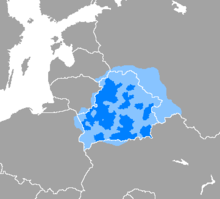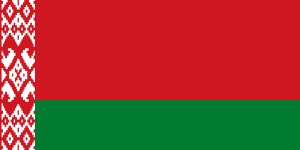Belarusian

Belarusian is an East Slavic language spoken by over 9 million people as a first language in Belarus and in other countries. The languages most similar to Belarusian are Russian, Ukrainian and Polish. At first, Russian, Ukrainian and Belarusian were considered during the Kievan Rus era (c. 862- c. 1240) as one common language known as Old Russian or Old East Slavic. Slowly, the languages evolved due to subjugation from Polish-Lithuania as well as the Austrian empire, which is marked by a large number of Polish (and other loan words) words in Ukrainian and Belarusian.

Belarusian exists in two forms, official and classical. This is due to the 1933 reform of the Belarusian language, which was not recognized by all Belarusians. The official (post-reform) language is dominant in Belarus while the classical (pre-reform) variety is maintained mainly by Belarusian emigrants in European and American countries. The official language is often referred to as наркамаўка "narkamauka" (i.e. the language of the narkam - narodnyi kamisaryiat, the soviet executive body that carried out the 1933 reform) while the classical variant is called тарашкевiца "tarashkevitsa" (the language of Bronislav Tarashkevich, who adopted the classical grammar and spelling of the language).
Belarusian historically had three alphabets: Cyrillic, almost identical to Russian, which is the official alphabet; Latin, similar to Polish or Lithuanian, which used to dominate in Polish-dominated Belarus during the interwar era, was never popular among Belarusians and is very rarely used even today; and Arabic, which was used by Muslim people during the Mongolian era (1240-1480) and by Muslims is now a kind of curiosity.
This book is based on Cyrillic "narkamauka" modern spelling reform of 1933, though we shall pay attention to spelling and grammar peculiarities of the classical variant.
Belarusian (sometimes obsoletely called Byelorussian or Belorussian, meaning "White Russian") can be a very tricky language to learn, especially if you don't have at least a basic knowledge of either Russian or Ukrainian. However, if you do know some Russian or Ukrainian, you'll be surprised how similar they are as they share the same alphabet (with a few cosmetic differences among themselves), the same grammatical rules, pitfalls, and a common history among them.
Table of Contents
[edit | edit source]Lesson 3 - Pronouns; Who/What is this?
Lesson 5 - Noun Gender and Number
Lesson 7 - Yes and No; This and That
Lesson 8 - Possessives; Asking for Definitions, Descriptions and Possession
Lesson 9 - Verbs Conjugation; You - Polite and Familiar
Lesson 10 - Adverbs; Short Answers; Nouns in ок; Verbs in аваць
Lesson 11 - Nouns Singular Genitive
Lesson 12 - Nouns Plural Genitive; Numbers from 1 to 10
Lesson 13 - Genitive of Adjectives and Other Words; Indefinite Words
Lesson 15 - Personal Names; Nouns Accusative; Likes and Dislikes
